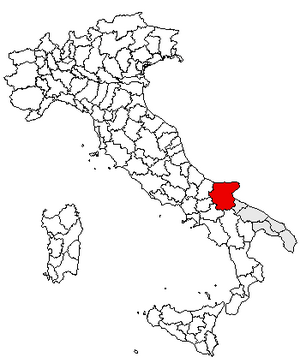Province of Foggia facts for kids
Quick facts for kids
Province of Foggia
Foggia
|
|
|---|---|
 |
|
| Country | |
| Region | Apulia |
| Capital | Foggia |
| Area | |
| • Total | 7,190 km2 (2,780 sq mi) |
| Population
(2005)
|
|
| • Total | 686,856 |
| • Density | 96/km2 (250/sq mi) |
| Postal Code |
71100
|
| Telephone prefix |
0881
|
| ISTAT | 071 |
| Vehicle registration | FG |
| No. of communes | 64 |
The Province of Foggia is a special area in the Apulia region of southern Italy. It is one of the many provinces that make up the country.
This province is also known by other names. People sometimes call it Daunia, named after the Daunians. They were an ancient tribe who lived here long before the Romans. Another old name is Capitanata. This name comes from the Middle Ages, when a leader called a catepan governed the area. The main city and capital of the province is Foggia.
Contents
Geography of Foggia Province
The Province of Foggia has three main parts, each with its own unique features.
The Tavoliere Area
The first part is called the Tavoliere. This area is flat and is centered around the capital city of Foggia. It is a very important farming region. People often call it "the granary of Italy" because it produces so much wheat. Other main crops grown here include grapefruit, olives, and tomatoes.
The Daunian Mountains
The second part is the Daunian Mountains. These mountains are found along the border with the regions of Molise and Campania. The mountains are mostly covered with thick forests and green pastures. Only small villages are scattered throughout this area. Farmers here mainly produce delicious hams and a special cheese called caciocavallo. In two villages, Faeto and Celle di San Vito, people speak a very rare dialect called Faetar, which comes from a language spoken in France.
The Gargano Peninsula
The third part is the Gargano. This area is a peninsula that sticks out into the sea, shaped like a spur on Italy's "boot." It has both mountains and a large forest called Foresta Umbra. This forest is special because its vegetation is like what you would find in Central Europe. It is one of the last parts of an ancient forest that once covered much of Italy. The name Umbra might come from the word ombra, meaning "shadow," because the forest is so thick that little sunlight reaches the ground.
The coast of Gargano has many beautiful beaches and places for tourists to stay. In the north, there are two large salt lakes: Lesina and Varano. The Gargano is also known for producing olives, olive oil, and various local foods from both the mountains and the sea.
Population and Towns
The Province of Foggia covers about 7,007 square kilometers (2,705 square miles). In 2012, it had a total population of 627,102 people. The province is made up of 61 towns, which are called comuni (singular: comune). You can find a full list of these towns in the Comuni of the Province of Foggia article.
Important Towns in Foggia Province
Here are some of the main towns in the province:
- Foggia: This is the capital city. It is the hometown of Umberto Giordano, a famous opera composer.
- San Severo: This used to be the capital. It is known as the hometown of Andrea Pazienza, a well-known comics artist.
- San Giovanni Rotondo: This town is famous because it was the home of Padre Pio. Many people visit the church devoted to him here.
- Manfredonia and Vieste: These are important cities for the church in Apulia.
- Vieste, Mattinata, and Peschici: These are popular places for tourists who want to enjoy the sea and beaches.
- Lucera: This town was once the home of Frederick II, Holy Roman Emperor in the early 1200s. During the Middle Ages, it was the most important town in the province.
Other interesting towns include:
- Cerignola: The hometown of Nicola Zingarelli, who created the famous Zingarelli Italian dictionary. It is also where Giuseppe Di Vittorio, a leader for workers' rights, was born.
- Torremaggiore: This is the hometown of Nicola Sacco, a famous figure from the Sacco and Vanzetti case.
- Troia: This town has a beautiful cathedral built in the 10th century.
- Margherita di Savoia, Apulia: This town is a major center for producing salt.
- Celle di San Vito and Faeto: These two small towns are unique because people here have spoken a very rare dialect of the Franco-Provençal language since the 1300s. This dialect, called Cigliaje and Faetar, is spoken by only about 1,400 people worldwide.
Economy of Foggia Province
Farming is still the most important part of Foggia's economy, even though it's not as dominant as it once was. Because of its strong agricultural output, the area is still known as the "granary of Italy." Most of the few factories in the province are focused on processing food.
For example, a large amount of the peeled tomatoes used in Europe come from the Province of Foggia. Every year, about two million tons of tomatoes are grown here. Farmers face challenges to make a living, and they often try to find ways to keep their costs low to survive in the competitive market.
Tourism in Foggia Province
Many people visit Foggia each year, especially Catholic pilgrims. They come to places like the Sanctuary of Saint Michael the Archangel in Monte Sant'Angelo. Pope John Paul II visited this sanctuary in 1987. Another popular site is nearby San Giovanni Rotondo, which was the home of Saint Pio of Pietrelcina from 1916 until he passed away in 1968.
Images for kids
See also
 In Spanish: Provincia de Foggia para niños
In Spanish: Provincia de Foggia para niños





